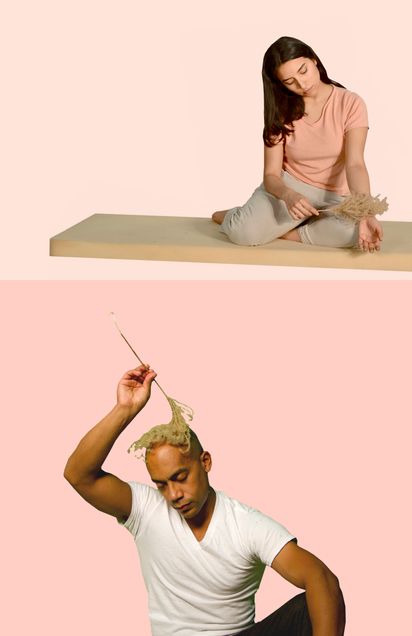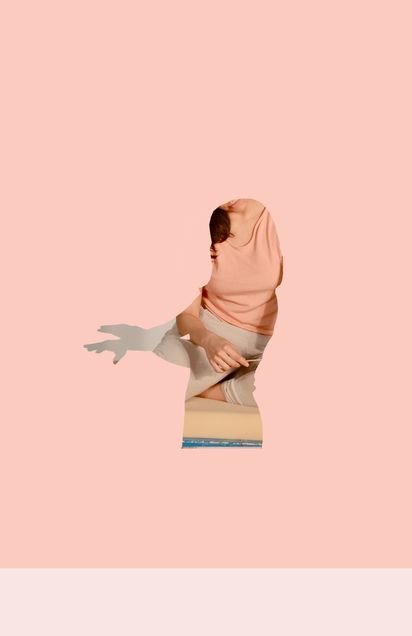news
Notes on Contributors
Sasha Goldman is a Ph.D. Candidate at Boston University. Her research focuses on Italian art and exhibition histories in the 20th and 21st centuries, with particular interests in artist-driven publications and exhibition catalogues, and temporary exhibitions and fairs. Her dissertation situates the artwork of Italian contemporary artist Maurizio Cattelan (b. 1960) in relation to the work of three seminal figures who are representative of major phases in recent Italian art, revealing how the shared strategies of Cattelan and his precursors demonstrate the fundamental role that history and national identity play in the work of Italian artists across the twentieth century.
Mariah Gruner is a Ph.D. candidate in American Studies at Boston University, where she has also earned a certificate in Women's and Gender Studies. She is currently working on her dissertation, titled "Stitching Selfhood, Materializing Gender: The Political Uses of Women's Decorative Needlework in the United States, 1820-1920." She also serves as the program coordinator for the Boston University Public Humanities Undergraduate Fellowship Program.
Anni Pullagura is a doctoral candidate in American Studies at Brown University. Her dissertation, “Seeing Feeling: The Work of Empathy in Exhibitionary Spaces,” explores the intersection of moral philosophy and visual culture in contemporary art and media. Currently, she is the Curatorial Fellow at the Institute of Contemporary Art, Boston.
Althea Ruoppo is a Ph.D. student studying modern and contemporary art in the Department of History of Art and Architecture at Boston University. Her research interests include postwar German art, trauma and the temporality and materiality of memory, and theories of repetition and reproduction.
Kate Sunderlin is a Ph.D. candidate at Virginia Commonwealth University currently writing her dissertation on the use of plaster in the nineteenth-century United States. She and her husband also own and operate the B. A. Sunderlin Bellfoundry in Ruther Glen, VA.
Julia Wilson is a photographic artist, who explores our relationship to, and the relationship between text and image, and photographic interpretation within contemporaneity. Using the large format view camera, Julia photographs images, words, reflections, and grit, composed on her personal computer screen. Julia received a Bachelor of Arts in Classical Studies with a concentration in Latin and Ancient Greek translation from the University of Virginia and recently received her Master of Fine Arts in photography at the Savannah College of Art and Design.
Alex Yen is a Ph.D. candidate at Boston University where she specializes in Roman art and archaeology. Her dissertation, “The Door Motif in Roman art: 100BCE-235CE” examines how Romans commonly represented and interpreted the image of the door across media as a symbol of physical and social mobility.
A Bodied Sound
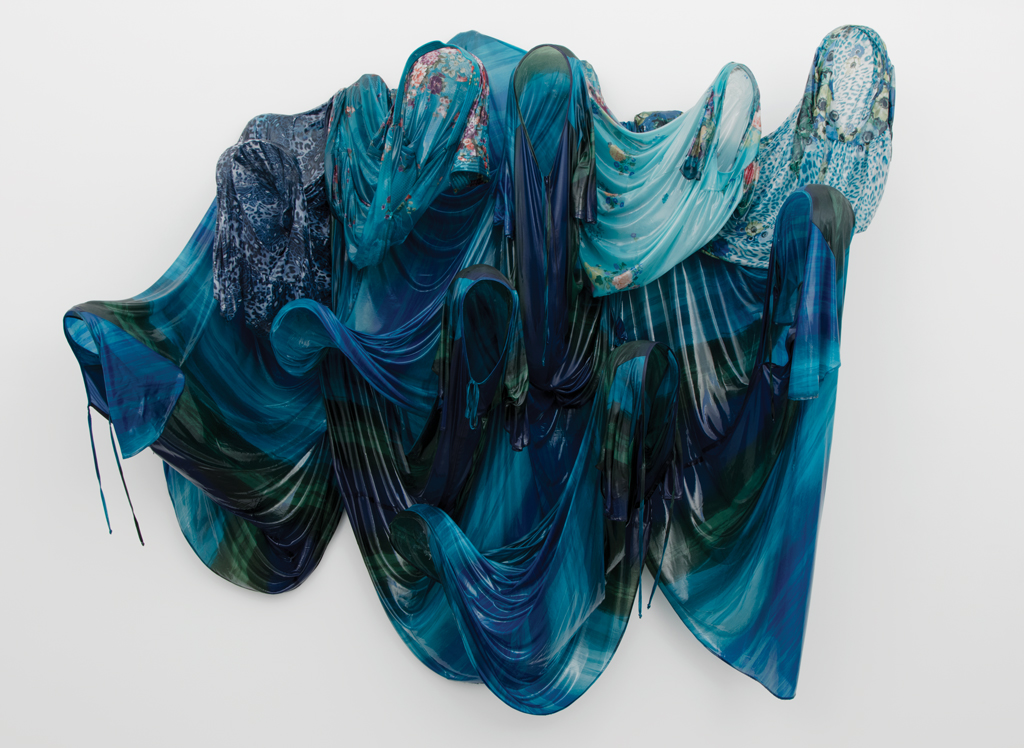
The body is a moving, singing thing. Every pulse, breath, beat unfolds with mechanical momentum, in a tempo set to the otherwise mundane activity of forward-moving life. Body sound, bodied sound: the pumping of blood, the intake of air, the movement of organs, the consuming of nourishment, and the expulsion of waste—this is the undercurrent for the differently- and multiply-abled alike, a form of life-listening composed predominantly of haptic sensibilities. Sound feels, because the body hears: it hears for what works, what fails, what disturbs, what leaves, what remains. But sound sees, too. Our vibrating matter is a visual as well as aural phenomenon, something intimated and visceral. As Fred Moten reminds us: “Sound gives us back the visuality that ocularcentricism had repressed.”[1] By tapping into the aesthetics of this shared haptic experience, Kevin Beasley’s aural sculptures shape themselves around exactly this sense of a bodied sound.
Stretched and dripped over yawning oval cores, Beasley’s hooded sculptures inscribe an ultimately soundless figure with a visualized anticipation of imminent sound. Beasley, who often works with acoustics and, even when he does not, thinks through the visuality of sound, builds these sculptural forms from housedresses acquired at the kind of corner fabric stores the women in his family and neighborhood would often visit to purchase readymade pieces or find fabrics to render their own. He soaks each found garment in resin and drapes them over Styrofoam mannequin heads affixed to microphone stands. As the resin hardens and the supports are removed, life-size ghosts emerge, curving elegantly and almost listlessly forward as they cling to the static force that suspends their tenuous weight. Something is arrested here, and something else is beginning to sound out.
Described variously as spectral and haunting, Beasley’s hooded sculptures entered his visual art practice on the heels of his ongoing sound-based works. Like an exercise in call-and-response, his installations have every appearance of possessing the vocal faculty Beasley demonstrates in his performances, in which he often remixes amateur recordings of conversations with family or friends alongside samples from recording artists or ambient noise from surrounding environments. His sound performances are laced with something not yet formed, as though containing within themselves a promised reward for close listening, while making any such opportunity nearly impossible. His sculptures, meanwhile, are open with another kind of tentative not-yet-there, gathered in a choral arrangement ready to sing but emptied of the possibility.
With or without the face, the body remains—or at least the threat of one. Visual culture studies scholar Tina Campt posits that everyday sound, the quotidian, is a “practice honed by the dispossessed in the struggle to create possibility within the constraints of everyday life.” [2] The dispossessed are not without sound; theirs is a sounding always present, ever gathered, continually pulsing. Perhaps moved to imagine what forms this dispossessed sound could take, Beasley began incorporating mixed sound into his hooded sculptures in the mid 2010s. In Phasing (Ebb) and Phasing (Flow), ambient gallery noise from adjoining rooms is picked up by hidden microphones and fed back to a receiving speaker situated before their respective work. The emitted sound is one in which the sculptures speak an assemblage of borrowed voices, of visitors idly passing, breathing, speaking by, of the background murmurings we are trained, by habit, to ignore. If not dispossessed, this is white noise made not meaningless but rhythmic, pulsing, vibrant, rehearsing over and over the sonic currents of the gallery space.
Channels are forged and re-forged in Beasley’s aural networks. Phasing (Ebb) is maybe even too channel-like, regurgitating the familiar into the unfamiliar, creating a loop both lyrical and menacing. This is a channeling different from other looped sculptural works Beasley has staged, such as Air Conditioner (Tempo), comprising the shell of an air conditioner set between a wall, only one half visible at any given time, while an audio track replays the dull, numbing ambient sound we rarely even notice. Therein is the trouble: background frequency is the lowly sound that should not register, but does, achingly. The quotidian is in fact full of noise; it opens new registers, or drags them, kicking and screaming, to the surface of our cognition. Sound, plainly speaking, is not to be dismissed but held, disrupted, dispersed, and claimed. Let us call this the “sounding” of being: “between bodies, in real time, in virtual time, in memory, in history, and across space.”[3]
If we ring ourselves into being, then we swallow the sounds that came before us and that will live somewhere, sometime, after us too. This is the kind of aural citation at work in Beasley’s 2014 performance at the Cozad-Bates House in Cleveland, Ohio. Entitled And in My Dream I Was Rolling on the Floor, in this work Beasley staged a four-part performance on a site once alleged to have been part of the Underground Railroad. Here, sound hinged on what Beasley imagined might once have been heard, and even still could be present, in the now condemned building, generating a sonic landscape suspended between times. It was this imprecise entanglement that first drew Beasley to traverse the visual and aural together. For Beasley, this exercise became “so much about observation and actually submitting to what is being projected, and that is a very vulnerable and revealing space to commit to, because you open yourself up to hearing something you may not understand, like, or agree with.”[4]
Agreement, especially the aural sense of it, is an odd thing to avoid. But noise, as David Novak reminds us, is disarming, distancing, and nauseating from its very phenomenological point of origin, “the Latin root of the word is nausea, from the Greek root naus for ship. The reference to seasickness captures the basic disorientation of the term: noise is a context of sensory experience, but also a moving subject of circulation, of sound and listening, that emerges in the process of navigating the world and its differences.”[5]
Becoming—aware, conscious, human—is sickeningly noisy. Beasley’s sculptural figures, in their own struggle to become, entice as much as they make us recoil. They speak on borrowed sound. Voraciously bright, they stretch their mouths out to reach us, leering and yearning, to bite vampirically into the breaths and words we utter before them.
And sometimes, we are the vultures. Bodied sound is circulatory, after all, and comes to rests, but never to ends. A sounding self is as much an ongoing encounter with what resounds as it is itself a process of becoming bodied, how phenomena consolidates into meaning. We register each other because—see, listen—“I sound better since you cut my throat.” [6]
Click here for more images of Beasley's work.
Anni Pullagura
____________________
[1]Fred Moten, In the Break: The Aesthetics of the Black Radical Tradition (Minneapolis and London: University of Minneapolis Press, 2003), 235.
[2] Tina Campt, Listening to Images (Durham and London: Duke University Press, 2017), 4.
[3] Gillian Siddall and Ellen Waterman, Negotiated Moments: Improvisation, Sound, and Subjectivity (Durham and London: Duke University Press, 2016), 2.
[4] Ruth Erickson, Kevin Beasley (Boston: The Institute of Contemporary Art/Boston, 2018), 65.
[5] David Novak, “Noise,” in Keywords in Sound, David Novak and Matt Sakakeeny, eds. (Durham and London: Duke University Press, 2015), 125.
[6] Fred Moten, “rock the party, fuck the smackdown,” Hughson’s Tavern (Providence: Leon Works, 2008).
Michelangelo: Divine Draftsman & Designer

Metropolitan Museum of Art, New York, NY
Nov 13, 2017 – Feb 12, 2018
The Metropolitan Museum of Art’s wide-ranging exhibition "Michelangelo: Divine Draftsman & Designer" examines the artistic production and development of the Renaissance master through his drawings. The exhibit is a result of the recent scholarly interest in drawings and their importance within the artistic process. The show spreads over twenty galleries and displays more than 200 works of art in diverse media: sculpture, paintings, architectural models, and drawings. On view are 133 drawings by Michelangelo, from fifty public and private collections in the United States and Europe, including studies of anatomy, preparatory sketches, as well as highly finished compositions. The exhibition celebrates Michelangelo as a disegnatore, draftsman, and demonstrates his extensive use of disegno, drawing, from his early days in Florence until his death in Rome.
The first gallery of the exhibition illuminates Michelangelo’s artistic background in the Florentine workshop of Domenico Ghirlandaio, a follower of the Florentine tradition of disegno, who explored diverse materials such as pen and ink, metal point, and black chalk. The exhibition demonstrates the themes Michelangelo explored in his drawings, particularly humanistic matters, as seen in Il Sogno, a presentation drawing meant to invoke intellectual debate (fig 1). Notable projects of Michelangelo are also featured; among them is the planning of the Tomb of Pope Julius II, who wished to have a grandiose tomb in St Peter’s Basilica.

While Michelangelo is known to have been a solitary person, curator Carmen Bambach revealed his engagement in artistic exchanges in the form of correspondence and his influence on other artists. Prominent in the exhibition is Michelangelo’s communication with Tommaso de’ Cavalieri, a Roman collector, who received Il Sogno and Cleopatra. The master also collaborated with other artists, such as Marcello Venusti, Daniele da Volterra, and Sebastiano del Piombo, who are included in the exhibit.

The main point of criticism concerning the curation of the exhibition is directed towards the gallery’s center which features preparatory drawings for the ceiling of the Sistine Chapel. The plethora of drawings demonstrates the painter’s artistic process and compositional planning. His artistic abilities and genius are also visible through the variety of materials, such as red and black chalks and ink. Hidden among the many drawings is the famed Studies for the Libyan Sibyl (fig 2). However, overshadowing these drawings, both literally and figuratively, is the digital projection of the famed ceiling in its completed state. Meant to situate the preparatory drawings within the greater context of their production, the digital projection, while novel in conception, unfortunately, served more as a visual distraction, divorcing drawings from the finished masterpiece (fig 3).
The renewed academic interest in Michelangelo’s drawings is shown to the public in this rich display of his oeuvre. Through his drawings, the exhibition effectively displays Michelangelo’s versatility as an artist as the works relate to all the artistic fields in which he was active. Beyond that, the exhibit shows him not as a solitary artist, but rather as one operating within a greater artistic network of patrons and artists.
Rebecca Arnheim
Takashi Murakami: Lineage of Eccentrics
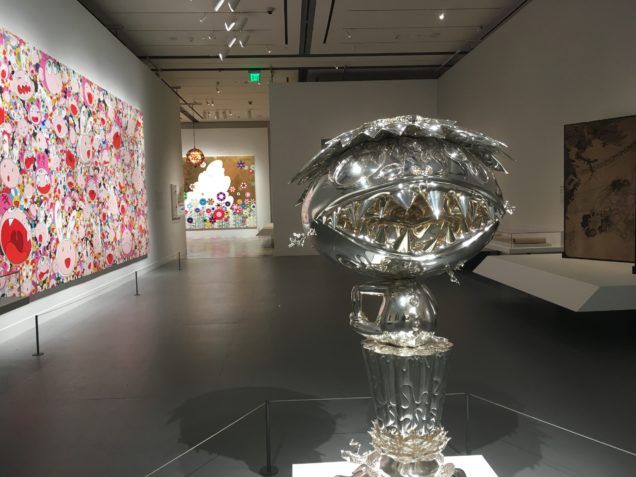
Museum of Fine Arts, Boston, MA
October 18, 2017 – April 1, 2018
The Museum of Fine Arts, Boston’s exhibition Takashi Murakami: Lineage of Eccentrics, organized in collaboration with Japanese art historian Professor Nobuo Tsuji, combines the contemporary art of Takashi Murakami with that of the MFA’s permanent Japanese art collection. The exhibition attempts to place Murakami’s work within a long historical lineage of Japanese artists who strayed away from tradition. While the selection of over thirty of the MFA’s exemplary pieces of Japanese masterpieces is stunning, many of them are overshadowed by Murakami’s extravagantly large (and social media worthy) images.
The exhibition provides a plethora of examples of some of the finest works of Japanese art, and makes the argument that Murakami, if not a part of this “Lineage of Eccentrics,” has taken inspiration from them. Placed within the same narrative space to create this lineage, the permanent collection works are grouped together in six categories: Superflat, Animation, Kazari, Asobi, Religiosity, and Eccentricity. While these images are prominently displayed, some, such as the folding screens in the Kazari room, become overshadowed by the work of Murakami (fig. 1). Though these works are meant to show Murakami’s inclusion in this lineage, the exhibition on the whole privileges Murakami’s work allowing the historic pieces to get lost along the way. Noting this favoring, the exhibition remains humorous and enjoyable making the art on display accessible and intriguing to all.
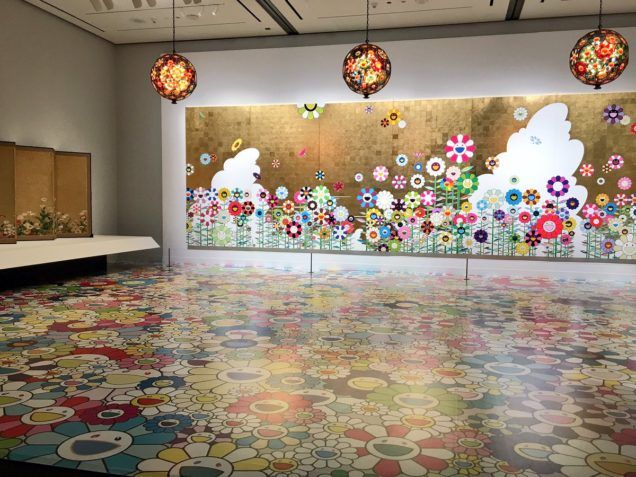
A highlight of the exhibition is the Kazari room which displays Murakami’s smiley face daisy mural Kawaii—Vacances: Summer Vacation in the Kingdom of the Golden with matching printed floor and light fixtures. Two brilliant folding screens from the MFA’s permanent collection frame the mural. These screens, Poppies(17th century, School of Tawaraya Sōtatsu) display floral scenes typical of seventeenth-century decorative art (fig. 2). On the wall leading to the room it is suggested that visitors take selfies and pictures with the work to prove they were here and to post on social media using the hashtag #mfaMurakami. Due to this and the monumental size of Murakami’s works, visitors largely ignore the screens and other surrounding works as they make their way towards a gift shop largely populated with expensive Murakami merchandise. The atmosphere of the exhibition then becomes less about lineage and more about Murakami, his work in relation to Japanese art, and the next great selfie.
Morgan Williamson
Notes on Contributors
Rebecca Arnheim is a second-year Ph.D. student in the Department of History of Art & Architecture at Boston University. She specializes in the Italian Renaissance, focusing on drawn portraits within the culture of Italian courts.
Bailey Benson is a doctoral student at Boston University, where she studies the art and architecture of ancient Rome. Her research interests include the role of women in ancient Greece and Rome, the articulation of identity and memory in the ancient world, and the archaeology of the Roman East. She was a graduate research intern in the Ancient Art department at the MFA from 2016 to 2017.
Steve Burges is a doctoral candidate at Boston University with a focus on Roman art and archaeology. He is currently writing a dissertation examining depictions of temporary funerary architecture on imperial coinage. It is entitled “Conflagration and Consecration: Funerary Pyres of the Roman Imperial Family from 138 to 235 CE.” He worked for the Department of Art of the Ancient World at the Museum of Fine Arts, Boston from 2014 to 2016.
Lane Eagles is a Ph.D. candidate at the University of Washington, Seattle focusing on the history of art and visual culture of late medieval and Renaissance Italy. Her research focuses on gender, fashion, magic, and miracles. She is also an adjunct instructor of art history at Seattle Pacific University.
Kearstin Jacobson is a second year Masters student at Montana State University where her research interests range from the ancient through medieval eras in the Mediterranean. Specifically, Kearstin looks to the shifting appearances or contexts of material objects and iconographies among peoples as the lingering markers of transculturation.
Kyla Kegler is an artist whose work probes the phenomenon of haptic sensation through multimedia experiences focused on tuning into subtle awarenesses of the body. Her research critically navigates the paradox of the mindfulness industry, to which she contributes as both an artist and as a practitioner. She is currently completing her MFA in visual art on full fellowship at the University at Buffalo.
Carlos Muñoz is a doctoral student at Boston University interested in Greek and Roman art and archaeology. He is writing a dissertation entitled “The Apoxyomenos: Meaning and Context of the Athlete with a Strigil in the Greek and Roman World.” Also, he is currently the graduate research intern at the Art of the Ancient World department at the Museum of Fine Arts, Boston until May 2018.
Jennifer Tafe is a PhD Candidate in Greek art at Boston University. Her doctoral dissertation, “Nikosthenes: Innovation and Identity in Late Archaic Vase Painting” examines the signed vases from a specific workshop as a model for understanding concepts of the artist and individual style in Athenian vase painting production and export.
Morgan Williamson is a MA student at Boston University studying Japanese Art.
Dwelling in Sensation
We live in an age of mass virtual mediation. This originates in the historical oppression of sensuality. Alongside sexual promiscuity and perversion, sensuality itself is repeatedly condemned in biblical texts.
During the rise of Fordist mass production and the Industrial Revolution in America, a Protestant work ethic prioritized efficient production over experience when the creative act of crafting was replaced by assembly lines. Sensual anesthesia was required for optimal efficiency.
Today we operate in the persistence of these fundamental ideologies, exacerbated by the addition of virtual technology.
As people increasingly experience and define themselves in virtual space, they are increasingly alienated from their bodies. Virtual avatars begin to eclipse human identities, divorcing us from material consequences of the physical world.
In light of these enlarged, mediated gaps in identification with the physical, there is a growing market in outsourced prosthetic self-connection methods.
Intuitive sensual awareness has become a novelty, commodified and sold back to us by the mindfulness industry.
We adjust to virtual overstimulation and find sensual dysphoria.
There is an inverse relationship between the frequency of external stimulation and the sensitivity of the organism: As the frequency of external stimulations increases, the threshold for feeling them increases, and the sensitivity of the organism decreases.
In creating a set of un-branded instructions for the user’s self-care, not predicated on my own presence as an instructor, this visual essay suggests readily available methods of experiencing daily decolonized physical sensation without the need for commodified mediation.
It posits that physical sensation is a fundamental aspect of arriving in present time and space, and that that sense of arrival contributes to empathy and contentment in the individual.
Kyla Kegler
Warburg’s Etruscan Florentines

In his 1932 watershed study, pioneering art historian Aby Warburg accused fifteenth-century Florentine cosmopolitan elites of unabashedly emulating “the superstitious Etruscans” in their devotional art practice.[1]This enigmatic quote—reproduced here in its porous entirety—has haunted art history for nearly a century:
By associating votive offerings with sacred images, the Catholic Church, in its wisdom, had left its formerly pagan flock a legitimate outlet for the inveterate impulse to associate oneself or one’s own effigy with the Divine as expressed in the palpable form of a human image. The Florentines, descendants of the superstitious Etruscans, cultivated the magical use of images in the most unblushing form, right down to the seventeenth century….[2]
Warburg remarks upon an extraneous variety of Renaissance portraiture known as the votior boti, full-scale waxwork effigies of patrician Italians. An eccentric historiographic remark upon an eccentric genre, this passage examines votispecifically dedicated to the Madonna of the Annunciation, athaumaturgic fresco in Santissima Annunziata, Florence (fig. 1).[3]Warburg’s text has not traversed decades of criticism unscathed. These words have been pried apart and dissected, opening debates concerning popular piety in fervently Catholic Renaissance Florence and meditations on the exact significance of Warburg’s enigmatic verbiage. Warburg based his contention that the Santissima effigies operated magically upon Julius von Schlosser’s 1910 treatment of wax portraits. Hugo van der Velden argues, however, that while the effigies were politically efficacious for the ruling class to maintain their presence in the minds of the public, they could not stand for the donor and were not linked to magic.[4]
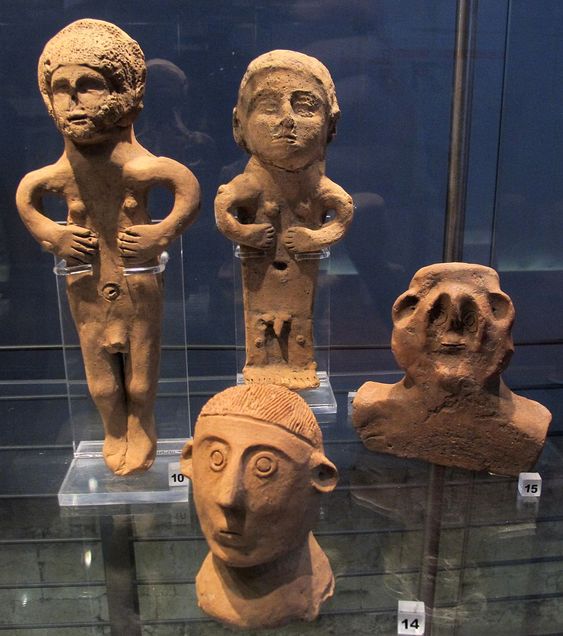
What did Warburg mean when he brandished the terms “pagan” and “magic?” This essay argues his comments refer specifically to sympathetic magic as a link between Etruscan and Florentine votive practices. Sympathy is the magical theory that a representation is numinously linked to the actual physical body of the represented person. It has long been central to magical phenomenon, and as a concept has informed magical practice spanning countless cultures. The theory depends on the law of contact or contagion, connecting like to like, but does not necessarily require verisimilar donor likeness to properly operate. Examining contemporary magical beliefs in both cultures clarifies Warburg’s words and the Santissima Annunziata cult itself.
The Madonna of the Annunciationfresco occupies the same spatial position today as it did upon its miraculous manifestation, in the back of Santissima Annunziata’s nave. Incited by its inherent divinity, the fresco has been considered miracle-working since its completion. To thank the fresco for bestowing blessings upon the populace, wealthy Renaissance Florentines commissioned life-sized waxwork effigies in their own likenesses for exhibition within the nave.[5]Effigy-style votives swelled in popularity during the early modern period; many churches in Italy hosted these devotional mannequins, but none was more popular than the cult that grew up around the Annunciation fresco in central Florence during the Quattrocento.
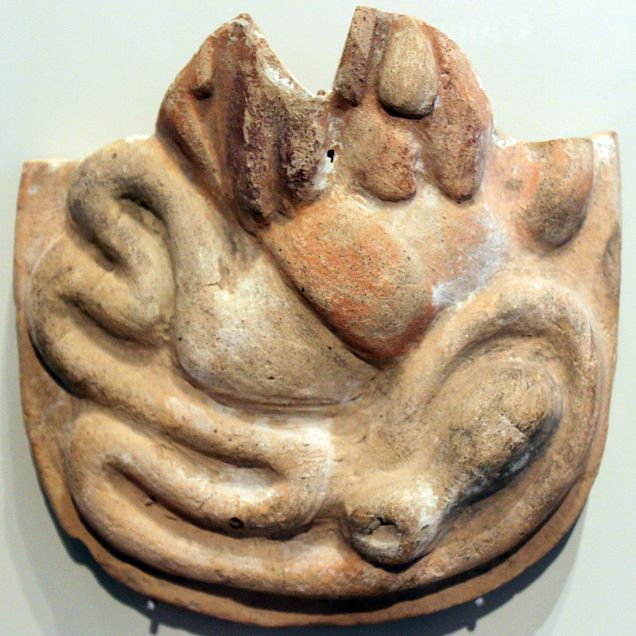
The sculptures foregrounded spectacle.[6]These figural dramas rendered in wax, precious metals, textiles, gemstones, and paint dominated the Basilica’s interior.[7]Specifically catered for the patron, the images were occasionally dressed in the actual clothing of the commissioner.[8]Life-sized knights astride horses covered in battle armor and high-ranking members of church hierarchy dressed in the robes of their order were among the most ostentatious.[9]One account tells of a true-to-life size pregnant woman depicted mid-labor atop an actual bed, hoping to be saved by the fresco from the dangers of childbirth.[10]Effigies of the most influential members of society—kings, nobles, and emperors—were positioned closest to the altar.[11]
The full-scale votiwere a highly-regarded art form, Andrea del Verrocchio’s workshop having produced many of the more elaborate examples.[12]Among the most famous stood Lorenzo de’Medici’s effigy, created in response to his escape from the Pazzi conspiracy, which he credited to the Madonna of the Annunciation.[13]Vasari claims Verrocchio and fellow wax-worker Orsino Benintendi “portrayed from life” the Medici votives, creating sculptures “arranged so beautifully that nothing better or more true to nature could be seen….so lifelike and so well wrought that they seemed no mere images of wax, but actual living men.”[14]
The wax effigy acted as a stand-in for the actual body, the living body, until the donor passed away and could be buried within the holy ground of the church. This forest of sculptures within Santissima Annunziata’s nave eventually became so untamed that the effigies were suspended from the ceiling. Occasionally they proved too heavy for their cords and the artworks came crashing to the ground.[15]To cope with the massive weight of the votives, the walls of Santissima Annunziata had to be reinforced during the last decade of the fourteenth century.[16]The effigies eventually grew too numerous for the basilica’s nave and were banished to the courtyard. Subsequently disposed of in the eighteenth century, none now survive.[17]

Warburg asserts Renaissance Florentines were acting upon unconscious impulses harkening back to ancient Etruria when commissioning and installing the Santissima wax sculptures.[18]To fully grasp the extent of Warburg’s claim, the art historian must consider sympathy. While Warburg does not mention this branch of magic in his treatment, it is often linked to medieval and Renaissance votive practice in Western Europe and beyond.[19]Etruscans practiced sympathetic magic, and their votive traditions held striking parallels to their Florentine successors. Loose likenesses of individuals were often deposited in Etruscan tombs with the hope that their real-life counterparts would suffer untimely ends (fig. 2).[20]In Etruscan settlements like Caere and Vignaccia, small votives in the shape of single body parts including heads, eyes, ears, limbs, breasts, and internal organs such as livers and uteri have been unearthed (figs. 3 and 4). These generic, fragmented body parts call for divine attention as they ask a member of the Etruscan pantheon for safe delivery from disease or other medical malady.[21]Fashioned from terracotta or lead rather than wax, the sculptures were linked sympathetically with the victim, but not by resemblance.
While Renaissance Florentines also created fragmented body part votives, the Santissima effigies were apex portraits, the Platonic form of portraits, fully achieving the Renaissance dream of portraiture which rendered the sitter via mimetic, one-to-one verisimilitude of their lived physicality and physiognomy. While we cannot know exactly how accurately the wax effigies within Santissima Annunziata represented each and every member of the faithful, they nevertheless resembled the donor and stood for them in their absence. Period voices from the late fifteenth and early sixteenth centuries uphold Vasari’s assertion that the Medici votives substituted their patrons. After the dynasty’s dismissal from Florence in 1492, Medici effigies were taken down; in 1512 one of Giuliano was raised, then Pope Leo X’s was destroyed in 1572.[22] In this way, the turbulent waves of Medici expulsion and re-entrance into Florence were mirrored in the removal and re-installment of their wax likenesses. Contemporary accounts refer to these instances as “killing” the effigies, and acts of “murder,” further evidencing the belief that the wax sculptures were considered successful donor surrogates.[23]In describing a controversy of a man forced to remove and rearrange some equestrian votives belonging to the powerful Falconieri family, contemporary writer Franco Sacchetti sarcastically penned, “may God forgive him.”[24]
Materiality is likewise central to Warburg’s contention. Warburg waxes poetic about wax, essentially arguing that the lost votives were very much portraits. Wax was intrinsically related to identity in fifteenth-century Florence. The practice of using seals to stamp one’s heraldic insignia onto an important document was widespread during this period. A finished seal speaks ofboth the physical act of stamping (therefore relating to the living body) and as a solidified signifier of the stamper’s personhood. A family’s insignia, stamped in wax or recreated on a piece of armor, was considered a stand-in for a single member of that family.[25]The wax effigy embodies an imprint of the votary.
The Santissima Annunziata cult is a metonym for Renaissance magical thinking through material display. Renaissance Florence was, as Warburg asserts, a magical place. Bartolomeo Masi, a sixteenth-century Florentine, claimed Lorenzo de’Medici wore a magical ring on his finger. The gemstone set in the jewelry stored a genie, to which il Magnifico attributed his good health and fortune for many years.[26]The genius statesmen also employed experimental magicians in his court, Marsilio Ficino and Pico della Mirandola.[27]In accordance with Warburg, I maintain Renaissance Florentines enjoyed a flexible, pluralistic world view that allowed them to practice magic and Catholicism simultaneously.[28]
Warburg posited the idea that Renaissance Florentines had far from given up their Etruscan roots, and believes that this ancient society was still very much alive and manifesting in contemporary Florence. When this early art historian sensationally compared fifteenth-century Florentine elites to their Etruscan ancestors, Warburg located patterns across time and place in accordance with his typical methodology. And while it is dangerous for scholars to leap across centuries and tie together disparate historical threads, sympathy was well at work in Renaissance Florence, where the full-bodied effigies engendered the Catholic Basilica della Santissima Annunziata as a magical space. Renaissance Florence indirectly inherited sympathetic magic from the Etruscans by borrowing its practices, installing votive likenesses in response to divine intervention. While the Renaissance is often touted as an age of scientific obsession, fifteenth-century Florentines believed in the effectiveness of magic and pursued its influence in both religious and secular venues. At work within demon-haunted, pre-Protestant Europe, the wax effigy performed gratitude within the holy-yet-magical space of Santissima Annunziata.
Lane Eagles
________________________________________________________________________
[1]Aby Warburg, “The Art of Portraiture and the Florentine Bourgeoisie,” in The Renewal of Pagan Antiquity: Contributions to the Cultural History of the European Renaissance(Los Angeles: Getty Research Institute, 1999), 189.
[2]Ibid.
[3] The Madonna of the Annunciationis Florence’s only acheiropoieton, an image created by divine intervention, which literally translates from the Greek as “not made by human hands.” Acheiropoieta were believed to be painted by godly, angelic, or divine hands. As such, it is Florence’s most revered wonder-working image, a honor it has held for the last six hundred years. According to a local legend, in 1340 the Servite painter-priest Bartholomeus had labored over the fresco for several days, tormented by his inability to suitably render the face of the Virgin Mary. Yet what Bartholomeus lacked in artistic skill he well made up for in faith. He prayed for many nights, and was rewarded for his devotion when one morning he returned to his daunting project to find it miraculously finished. See Maria Husabo Oen, “The Origins of a Miraculous Image: Notes on the Annunciation Fresco in SS. Annunziata in Florence,” Journal of Art History no. 80 (2011), 5-7.
[4] The debate pits Warburg and Scholsser’s shared contentions against van der Velden who maintains “that the effigies were simply representations of a spiritual process or attitude,” but not magical. See Christopher S. Wood, “The Votive Scenario,” RES: Anthropology and Aesthetics vol. 59, no. 60 (2011), 224, and Hugo van der Velden, The Donor’s Image: Gerard Loyet and the Votive Portraits of Charles the Bold (Turnhout: Brepols, 2000), 126-385.
[5] Warburg, “The Art of Portraiture and the Florentine Bourgeoisie,” 190.
[6]Ibid., 189.
[7]Roberta Panzanelli, Ephemeral Bodies: Wax Sculpture and the Human Figure(Los Angeles: Getty Research Institute, 2008), 14.
[8] Oen, “The Origins of a Miraculous Image,” 1.
[9] Megan Holmes, “Ex-votos: Materiality, Memory and Cult,” in The Idol in the Age of Art: Objects, Devotions and the Early Modern World(Chicago: The University of Chicago Press, 2009), 166.
[10] Warburg, “The Art of Portraiture and the Florentine Bourgeoisie,” 207.
[11] Panzanelli, Ephemeral Bodies: Wax Sculpture and the Human Figure,15.
[12]Warburg, “The Art of Portraiture and the Florentine Bourgeoisie,” 190.
[13] On April 26, 1478, members of the Pazzi family endeavored to end the Medici’s de facto sovereignty over formally-republican Florence. Within the Duomo, Pazzi assassins converged upon the Medici as the priest raised the chalice for mass. Lorenzo il Magnifico was wounded and survived, but his brother Giuliano de’Medici perished in the attack. The Pazzi were subsequently exiled from Florence. See Richard Trexler,Public Life in Renaissance Florence(New York: Academic Press, 1980), 441.
[14]Giorgio Vasari, “Andrea del Verrocchio,” in The Lives of the Artists, Julia Conaway Bondanella & Peter E. Bondanella, eds. (Oxford: Oxford University Press, 1998), Vol 2, 1550, 2.
[15] Oen and others pull this anecdote from the eyewitness account of fifteenth-century writer Franco Sacchetti. See Oen, “The Origins of a Miraculous Image,” 3.
[16]Ibid.
[17] Warburg, “The Art of Portraiture and the Florentine Bourgeoisie,” 190. In addition to the primary accounts Warburg glossed, the closest extant comparisons to the Santissima wax effigies are on display in Santa Maria della Grazie in Mantua, and date from the sixteenth century.
[18]Ibid.
[19] Wouter J. Hanegraaff, “Sympathy of the Devil: Renaissance Magic and the Ambivalence of Idols,” Esoterica vol. 2 (2000), 2.
[20]For a more detailed explanation of this practice, as well as other examples of Etruscans using objects for magic see Sybille Haynes, Etruscan Civilization: A Cultural History (Los Angeles: The J. Paul Getty Museum, 2000), 283.
[21] Jean MacIntosh Turfa, “Anatomical Votives and Italian Medical Traditions” in Murlo and the Etruscans: Art and Society in Ancient Etruria,Richard Daniel De Puma and Jocelyn Penny Small, eds. (Madison: The University of Wisconsin Press, 1994), 224.
[22]Hugo van der Velden, “Medici Votive Images and the Scope and Limits of Likeness,” in The Image of theIndividual: Portraits in the Renaissance,Nicholas Mann and Luke Syson, eds. (London: British Museum Press, 1998), 134.
[23]Ibid., 134-135.
[24] Warburg, “The Art of Portraiture and the Florentine Bourgeoisie,” 205.
[25]Hans Belting, An Anthropology of Images: Picture, Medium, Body(Princeton: Princeton University Press, 2011), 65.
[26] Richard Trexler,Public Life in Renaissance Florence, 446.
[27] Hans Peter Broedel, The Malleus Maleficarum and the Construction of Witchcraft: Theology and Popular Belief(New York: Manchester University Press, 2003), 174.
[28] Warburg, “The Art of Portraiture and the Florentine Bourgeoisie,” 190-191.
Figure 4. Anatomical Votive Offering from Central Italy, 4th century BCE, terracotta,
Y 581, Altes Museum, Berlin, Germany (photo credit: Creative Commons).
Everyday Extravagance: Displaying the Art of Greek Daily Life at the Museum of Fine Arts, Boston
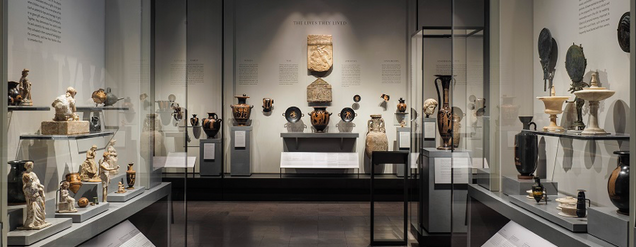
Life in Ancient Greece Gallery at the Museum of Fine Arts, Boston. (Photograph © Museum
of Fine Arts, Boston).
Three years after opening the innovative galleries devoted to Greek epics, theater, and the symposium, the Museum of Fine Arts, Boston (MFA) debuted another permanent installation of 250 additional objects from its robust collection of antiquities.[1]The spacious gallery, Daily Life in Ancient Greece, prompts visitors to engage with the remarkable material culture of Greek day-to-day life rather than mythological representations (fig. 1). Many artifacts on display, such as a surgeon’s toolkit, a child’s articulated doll, a model barbershop, and a scene of female athletes bathing, contribute to a narrative of individual experiences and reflect quotidian aspects of ancient Mediterranean society that have remained largely unexamined within both academic and curatorial spheres.
As curators of the new installation, Dr. Christine Kondoleon, the George D. and Margo Behrakis Senior Curator of Greek and Roman Art, and Dr. Phoebe Segal, the Mary Bryce Comstock Curator of Greek and Roman Art, employed modes of display which elucidate rather than obscure the intricacies and ambiguities of everyday objects. Rows of parallel cases present the interrelated familial themes of livelihood, domestic activity, childhood, and mourning, and at the rear of the gallery, a perpendicular display devoted to the communal subjects of competitive athletics and military training disrupts the preceding arrangement. The writers of the present article, who served as graduate research interns for the gallery, investigated examples of the extraordinary artistic expressions that permeated each of the various categories of Greek culture represented. We present the results of our work along with an interactive exhibition graphic, which preserves the object relationships established by novel gallery design and enhances the interpretative narrative (fig. 2).

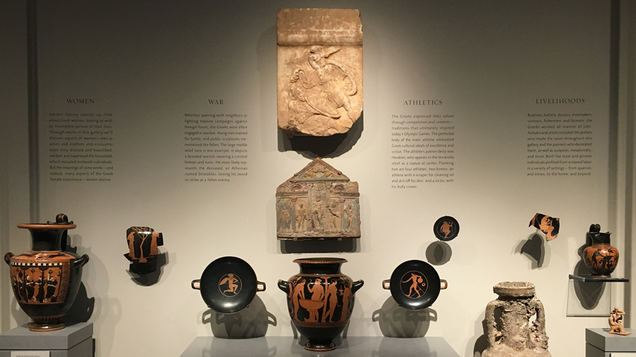
At the entrance to the gallery, the interior of a drinking cup (kylix) depicts a man squatting, defecating, and wiping with a stone (fig. 3). Without household plumbing, toilet paper, or soap, this would have been a common sight.[2]Painted images on vessels of defecating, urinating, or vomiting men, appearing frequently between 530 and 470 BCE, portray intoxicated revelers relieving themselves after a heavy night of drinking.[3]Wine concealed these internal decorations, which only came to light as the cup was emptied. Designed to take drinkers by surprise, such jokes or visual puns warned of the consequences of drunkenness and excessive indulgence.[4]

Another kylix portrays a satyr chiseling the vertical grooves into a column between his legs (fig. 4).
A wineskin in the background suggests he is perhaps already inebriated, possibly sneaking drinks throughout the day as would befit the uninhibited lifestyle of a satyr. The cup’s user would have recognized the phallic column, and the implied joke, “working with the hand” or “handiwork”, references masturbation.[5] The unexpected scenes impose upon museum audiences the commonplace obscenities and excesses of the typical drinking parties enjoyed by elite Greek men.

A more somber moment appears on a monumental marble replica of a lekythos,or oil jar, dated to around 390 BCE (fig. 5). Dedicated as a tomb marker for a woman named Nikagora, its iconography conforms to the standard language of Greek funerary monuments, but the state of its surviving painted decoration, commonly referred to as polychromy, sets this gravestone apart.[6]Bands of geometric designs frame the main pictorial scene, represented in relief, and tendrils of vegetal decoration curl along the vessel’s shoulder and climb its high neck. Viewed with the naked eye, the preserved pigmentation appears dull and muted. However, after the conservation team employed the use of infra-red and ultraviolet light in addition to digital x-radiography, the vessel lit up with traces of color. The enhanced images reveal previously invisible pigment: slender triangles in Egyptian blue encircle the lower register, one woman’s garment was originally an eye-catching shade of yellow, and red iron oxide was liberally employed. This lekythos imparts an important, and often forgotten, reality of the ancient lived experience: vibrant color was everywhere.

Opposite the remembrance and mourning displays, an assemblage of artifacts related to the Greek military recognizes the impact of frequent warfare on the lives of citizen-soldiers (fig. 6). The works selected range from battle-worn arms and armor to vases depicting individual warriors bidding their families ceremonial farewells. A convex shield produced in the second half of the sixth century BCE measures 82 centimeters in diameter, but its decoration was restricted to minute figural reliefs on the bronze arm strap attached to the reverse. The sole surviving scene that is identifiable depicts a woman consoling a grieving hero (fig. 7). Through an analysis of comparable small-scale artworks, this iconography closely corresponds to portrayals of the grief-stricken warrior Achilles met by his mother, Thetis, who would procure a set of armor for him.[7]Visible only to the infantryman holding the shield, such images construed the personal experiences of war and reflected the reality that each citizen-soldier’s family supplied their arms.
In Daily Life in Ancient Greece, surprises abound within the general vision of the daily experience of the ancient Greeks. Discovering the timing of visual puns within wine cups, the vibrancy of a well-adorned and colorful tomb marker, and the self-referential imagery behind an imposing shield reveal continuity in the artistry found throughout everyday objects. The multifaceted layers of the lives on display bring visitors to the gallery beyond the ordinary and into the extra-ordinary.

Bailey Benson, Steve Burges and Carlos Muñoz
Special thanks to Mike Tom, Department of Public Relations, Museum of Fine Arts, Boston
_______________________________________________________________________________________
[1]The Wine, Poets, and Performers in Ancient Greece Galleries are rooms 215A-C in the MFA, and the new Daily Life in Ancient Greecegallery spans rooms 212A-B, abutting the Michael C. Ruettgers Gallery for Ancient Coins in room 212C.
[2]John K. Papadopoulos, “Παιζω η χεζω? A contextual approach to pessoi (gaming pieces, counters, or convenient wipes?),” Hesperia71 (2002): 423-427.
[3]Alexander G. Mitchell, Greek Vase-Painting and the Origins of Visual Humour(Cambridge: Cambridge University Press, 2009): 90-91.
[4]Ibid.
[5]Ibid., 195-96.
[6]Mary Comstock and Cornelius Vermeule, Sculpture in Stone: The Greek, Roman, and Etruscan Collections of the Museum of Fine Arts, Boston (Boston: The Museum of Fine Arts, 1976), 51.
[7]Close comparisons are found in Etruscan depictions of “Achle,” such as the British Museum gem of the first half of the fifth century (1867,0507.414) where the hero, who is labeled, takes a very similar pose. (Leonard Muellner, “Grieving Achilles,” in Homeric Contexts: Neoanalysis and the Interpretation of Oral Poetry, eds. Franco Montanari, Antonios Rengakos, and Christos Tsagalis, 197-220 (Boston: De Gruyter, 2012): 198-205.)
Editors’ Introduction

In this issue, SEQUITUR explores the additive, the extraneous, and the unanticipated through the concept of “extra.” First conceptualized by the editors in relation to the millennial catchphrase, “being extra,” the editors challenged submissions to consider this notion as it relates to artistic practice, exhibition design, patronage, and decoration. The following issue provides thought-provoking scholarship expanding the theme across millenia and media. These contributions ultimately show that “extra” is often something unexpected, whether it be magical, uncomfortable, or simply extra-ordinary.
The two feature essays study the importance of abundance in crafting a patron’s identity. Lane Eagles reviews the art historical debates surrounding the popular Italian Renaissance portraiture-type known as the voti or boti, full-scale waxwork effigies of patrician Italians that were placed before miracle-working images in the hopes of bestowing blessings on the commissioner. Kearstin Jacobson identifies how ancient Roman women adorned themselves in layers of gold jewelry, similar to the practice of male insignia, in order to construct socially recognizable identities and status for the wearer.
Kyla Kegler’s visual essay responds to the age of mass virtual overstimulation. This work presents an illustrated self-care guide on how to return to and tend to our need for physical sensation and sensuality. By re-familiarizing ourselves with the tactile users will become more present.
This issue’s research spotlight by Bailey Benson, Steve Burges, and Carlos Muñoz examines the Museum of Fine Arts, Boston’s newest ancient art gallery, Daily Life in Ancient Greece, which exhibits remarkable everyday material culture from ancient Greece. A linked tour of the gallery space provides readers with virtual access to the museum display.
The two exhibition reviews discuss the varying ways in which a museum conceptualizes blockbuster exhibitions. Rebecca Arnheim explores the Metropolitan Museum of Art’s exhibition, Michelangelo: Divine Draftsman & Designer, which illuminates Michelangelo’s artistic background in the Florentine tradition of disegno. Morgan Williamson critiques the Museum of Fine Arts, Boston’s Takashi Murakami: Lineage of Eccentrics exhibition by questioning the effects of social media on contemporary museum exhibitions.
The issue concludes with Jennifer Tafe’s reflection on Boston University’s 34th annual Graduate Symposium in the History of Art & Architecture, which was held on March 2-3, 2018, at the Boston University Art Gallery and the Museum of Fine Arts, Boston. Titled “Excess,” this year’s symposium partly inspired our issue’s theme. The keynote address by Dr. Cary Levine, Associate Professor of Contemporary Art at the University of North Carolina at Chapel Hill, discussed Paul McCarthy’s “food flinging frenzies” takingthe audience on an at times distressing visual journey into the artist’s performance and video work.
We would like to offer a special thanks to our outgoing Senior Editor Joe Saravo and Junior Editor Kelsey Gustin. Thank you for all your hard work—your editorial eyes will be missed!
Lauren Graves
Keeping Up Appearances: Jewelry as Female Insignia in the Shadow of Vesuvius

In ancient Rome, social constructs moderated any form of luxurious decoration, personal or otherwise, by linking them to an excessive – and therefore morally questionable – lifestyle. Yet, documented parallels between decoration and identity reveal that only conservative Roman citizens in socio-political centers avoided decorative adornment, whereas others relegated their decorative predilections to more rural locales in order to avoid being labeled ostentatious, vulgar, or extra.[1] In his written histories, Pliny the Elder implies that the women of first-century Rome adorned themselves in gold jewelry to signal personal identity in a manner similar to elite men who wore insignia. Consisting of gold rings, bracelets, fibulæ garment fasteners, and bullæ necklaces signifying personal or familial military rank, male insignia constructed socially recognizable identities and status for the wearer. With a tinge of sarcasm, Pliny compares the golden foot and leg ornaments worn by youthful male attendants at the Roman baths to those worn as insignia by women of the merchant class, whose ostentation he ridicules.[2] By creating jewelry as their own female insignia that accented and defined the real estate of their bodies, women communicated their identity and compensated for their inability to access political and military adornments.[3] Providing an excellent, intact, example of how Roman women used jewelry is Oplontis, an archaeological site consisting of two buildings on the Bay of Naples in the Campanian region of Italy that suffered in the destructive path of the AD 79 eruption of Vesuvius.[4] Focusing on one preserved woman, skeleton 27, from the building called Oplontis B, I argue that her worn jewelry can be read not as an extra, arbitrary display of wealth donned for the love of ornamentation, but rather as female insignia which conveyed her personal identity as an upper-middle class matron, as supported by the archaeological record.






